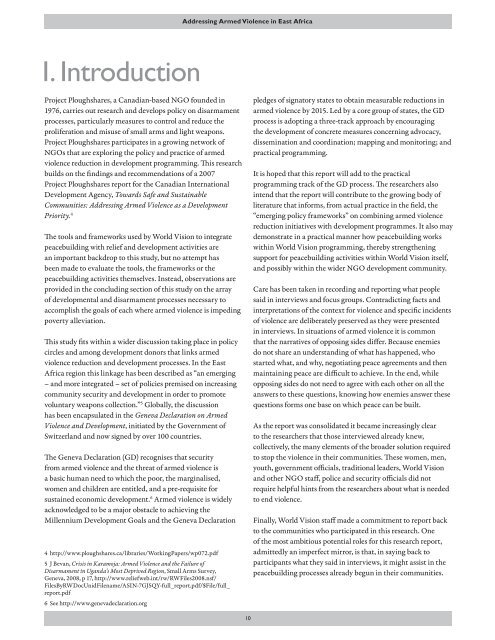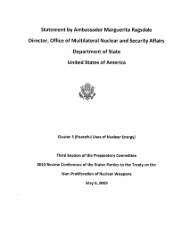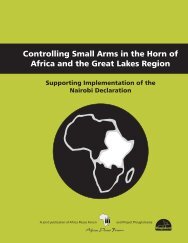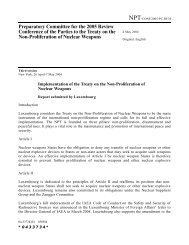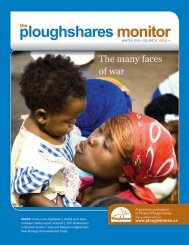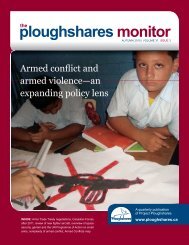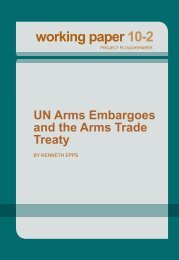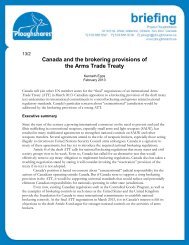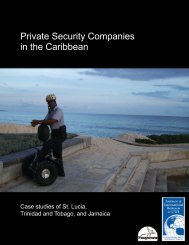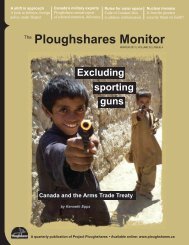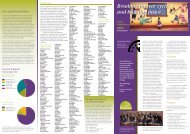Addressing Armed Violence in East Africa.pdf - Project Ploughshares
Addressing Armed Violence in East Africa.pdf - Project Ploughshares
Addressing Armed Violence in East Africa.pdf - Project Ploughshares
You also want an ePaper? Increase the reach of your titles
YUMPU automatically turns print PDFs into web optimized ePapers that Google loves.
<strong>Address<strong>in</strong>g</strong> <strong>Armed</strong> <strong>Violence</strong> <strong>in</strong> <strong>East</strong> <strong>Africa</strong>1. Introduction<strong>Project</strong> <strong>Ploughshares</strong>, a Canadian-based NGO founded <strong>in</strong>1976, carries out research and develops policy on disarmamentprocesses, particularly measures to control and reduce theproliferation and misuse of small arms and light weapons.<strong>Project</strong> <strong>Ploughshares</strong> participates <strong>in</strong> a grow<strong>in</strong>g network ofNGOs that are explor<strong>in</strong>g the policy and practice of armedviolence reduction <strong>in</strong> development programm<strong>in</strong>g. This researchbuilds on the f<strong>in</strong>d<strong>in</strong>gs and recommendations of a 2007<strong>Project</strong> <strong>Ploughshares</strong> report for the Canadian InternationalDevelopment Agency, Towards Safe and Susta<strong>in</strong>ableCommunities: <strong>Address<strong>in</strong>g</strong> <strong>Armed</strong> <strong>Violence</strong> as a DevelopmentPriority. 4The tools and frameworks used by World Vision to <strong>in</strong>tegratepeacebuild<strong>in</strong>g with relief and development activities arean important backdrop to this study, but no attempt hasbeen made to evaluate the tools, the frameworks or thepeacebuild<strong>in</strong>g activities themselves. Instead, observations areprovided <strong>in</strong> the conclud<strong>in</strong>g section of this study on the arrayof developmental and disarmament processes necessary toaccomplish the goals of each where armed violence is imped<strong>in</strong>gpoverty alleviation.This study fits with<strong>in</strong> a wider discussion tak<strong>in</strong>g place <strong>in</strong> policycircles and among development donors that l<strong>in</strong>ks armedviolence reduction and development processes. In the <strong>East</strong><strong>Africa</strong> region this l<strong>in</strong>kage has been described as “an emerg<strong>in</strong>g– and more <strong>in</strong>tegrated – set of policies premised on <strong>in</strong>creas<strong>in</strong>gcommunity security and development <strong>in</strong> order to promotevoluntary weapons collection.” 5 Globally, the discussionhas been encapsulated <strong>in</strong> the Geneva Declaration on <strong>Armed</strong><strong>Violence</strong> and Development, <strong>in</strong>itiated by the Government ofSwitzerland and now signed by over 100 countries.The Geneva Declaration (GD) recognises that securityfrom armed violence and the threat of armed violence isa basic human need to which the poor, the marg<strong>in</strong>alised,women and children are entitled, and a pre-requisite forsusta<strong>in</strong>ed economic development. 6 <strong>Armed</strong> violence is widelyacknowledged to be a major obstacle to achiev<strong>in</strong>g theMillennium Development Goals and the Geneva Declaration4 http://www.ploughshares.ca/libraries/Work<strong>in</strong>gPapers/wp072.<strong>pdf</strong>5 J Bevan, Crisis <strong>in</strong> Karamoja: <strong>Armed</strong> <strong>Violence</strong> and the Failure ofDisarmament <strong>in</strong> Uganda’s Most Deprived Region, Small Arms Survey,Geneva, 2008, p 17, http://www.reliefweb.<strong>in</strong>t/rw/RWFiles2008.nsf/FilesByRWDocUnidFilename/ASIN-7GJSQY-full_report.<strong>pdf</strong>/$File/full_report.<strong>pdf</strong>6 See http://www.genevadeclaration.orgpledges of signatory states to obta<strong>in</strong> measurable reductions <strong>in</strong>armed violence by 2015. Led by a core group of states, the GDprocess is adopt<strong>in</strong>g a three-track approach by encourag<strong>in</strong>gthe development of concrete measures concern<strong>in</strong>g advocacy,dissem<strong>in</strong>ation and coord<strong>in</strong>ation; mapp<strong>in</strong>g and monitor<strong>in</strong>g; andpractical programm<strong>in</strong>g.It is hoped that this report will add to the practicalprogramm<strong>in</strong>g track of the GD process. The researchers also<strong>in</strong>tend that the report will contribute to the grow<strong>in</strong>g body ofliterature that <strong>in</strong>forms, from actual practice <strong>in</strong> the field, the“emerg<strong>in</strong>g policy frameworks” on comb<strong>in</strong><strong>in</strong>g armed violencereduction <strong>in</strong>itiatives with development programmes. It also maydemonstrate <strong>in</strong> a practical manner how peacebuild<strong>in</strong>g workswith<strong>in</strong> World Vision programm<strong>in</strong>g, thereby strengthen<strong>in</strong>gsupport for peacebuild<strong>in</strong>g activities with<strong>in</strong> World Vision itself,and possibly with<strong>in</strong> the wider NGO development community.Care has been taken <strong>in</strong> record<strong>in</strong>g and report<strong>in</strong>g what peoplesaid <strong>in</strong> <strong>in</strong>terviews and focus groups. Contradict<strong>in</strong>g facts and<strong>in</strong>terpretations of the context for violence and specific <strong>in</strong>cidentsof violence are deliberately preserved as they were presented<strong>in</strong> <strong>in</strong>terviews. In situations of armed violence it is commonthat the narratives of oppos<strong>in</strong>g sides differ. Because enemiesdo not share an understand<strong>in</strong>g of what has happened, whostarted what, and why, negotiat<strong>in</strong>g peace agreements and thenma<strong>in</strong>ta<strong>in</strong><strong>in</strong>g peace are difficult to achieve. In the end, whileoppos<strong>in</strong>g sides do not need to agree with each other on all theanswers to these questions, know<strong>in</strong>g how enemies answer thesequestions forms one base on which peace can be built.As the report was consolidated it became <strong>in</strong>creas<strong>in</strong>gly clearto the researchers that those <strong>in</strong>terviewed already knew,collectively, the many elements of the broader solution requiredto stop the violence <strong>in</strong> their communities. These women, men,youth, government officials, traditional leaders, World Visionand other NGO staff, police and security officials did notrequire helpful h<strong>in</strong>ts from the researchers about what is neededto end violence.F<strong>in</strong>ally, World Vision staff made a commitment to report backto the communities who participated <strong>in</strong> this research. Oneof the most ambitious potential roles for this research report,admittedly an imperfect mirror, is that, <strong>in</strong> say<strong>in</strong>g back toparticipants what they said <strong>in</strong> <strong>in</strong>terviews, it might assist <strong>in</strong> thepeacebuild<strong>in</strong>g processes already begun <strong>in</strong> their communities.10


